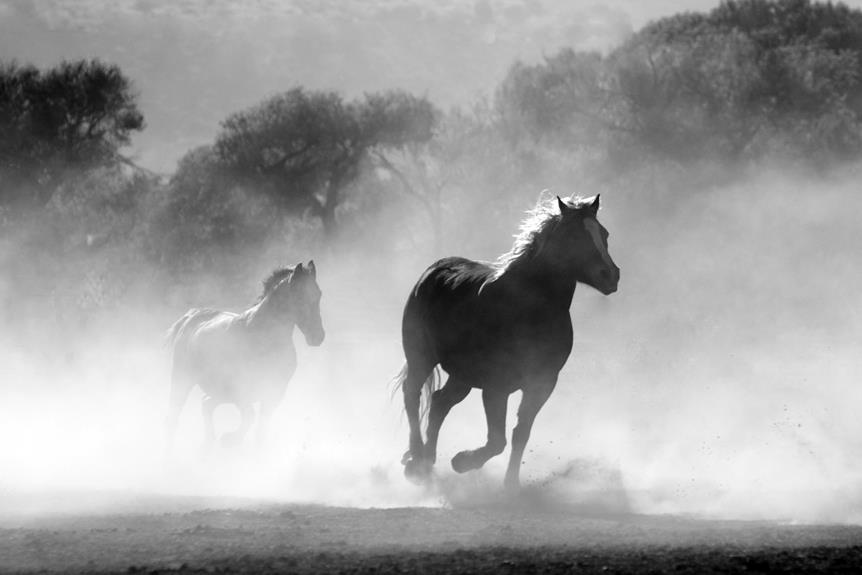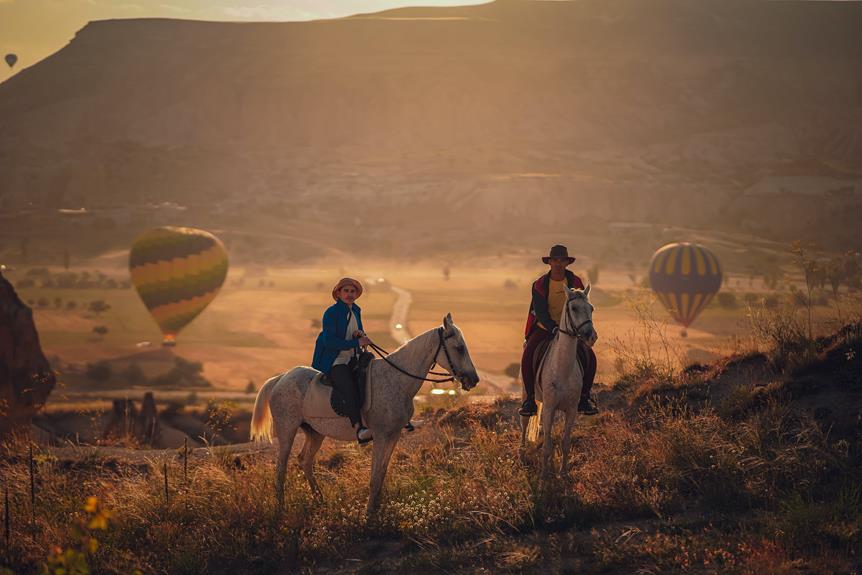When it comes to horse travel, have you ever wondered just how far these magnificent creatures can go in a single day? The answer may surprise you. Factors such as terrain, weather, and the horse's fitness level all come into play, affecting the actual distance covered.
But that's not all – there is a breed of horses known for their incredible endurance, capable of traveling up to 100 miles in a day. So, whether you're planning a long journey or simply curious about the capabilities of these majestic animals, there's much more to uncover about how far a horse can truly travel in a day.
Key Takeaways
- Factors such as breed, age, fitness level, terrain, and weather influence a horse's travel distance.
- The average horse can cover 20-30 miles per day, while well-trained endurance horses can travel up to 100 miles in a day.
- Terrain and weather conditions greatly impact a horse's speed and distance.
- The horse's health and fitness, as well as the rider's skills and equipment, play a significant role in determining travel distance.
Factors Affecting Horse Travel Distance
Factors such as breed, age, fitness level, terrain, and weather greatly influence a horse's travel distance. When it comes to horse travel distance, these factors play a crucial role in determining how far a horse can go in a day. The average horse can cover about 20 to 30 miles per day, depending on its overall health and fitness.
However, well-trained endurance horses can travel much longer distances. Endurance horses are specifically bred and conditioned to cover long distances, and they can cover up to 100 miles in a single day.
The average speed at which a horse can travel also depends on the terrain and weather conditions. Horses may struggle to cover long distances if they encounter steep or difficult terrain. Similarly, extreme weather conditions such as excessive heat or cold can also affect a horse's travel distance.
Additionally, access to water plays a crucial role in a horse's ability to travel long distances. Horses need regular access to water to stay hydrated and maintain their stamina.
Rest and recovery are also vital for horses during long journeys. Horses may need rest breaks to avoid exhaustion and recover their energy.
Taking these factors into account can help ensure that horses can travel long distances safely and comfortably.
Impact of Breed and Age on Travel Distance
Considering the significant impact of breed and age on a horse's travel distance, it's essential to understand how these factors influence their endurance and ability to cover long distances.
- Breed: Different horse breeds have varying endurance levels, which directly affect how far they can travel in a day. For example, Arabian horses are known for their exceptional stamina and can cover long distances at a consistent pace. On the other hand, draft breeds, such as Clydesdales, aren't built for endurance and may struggle to maintain the same distance as Arabians.
- Age: Age also plays a crucial role in a horse's travel distance. Younger horses, especially those under three years old, have less stamina compared to mature horses. Their bodies are still developing, and they may tire quickly, limiting the distance they can cover in a day. As horses age, their endurance generally improves, allowing them to travel longer distances.
It's important to note that these factors aren't the sole determinants of a horse's travel distance. Other factors, such as the horse's overall health, training, and the terrain/weather conditions, also come into play. A well-trained horse with good health can cover more miles in a day compared to an unfit or untrained horse. Additionally, the rider's weight and equipment can affect the horse's travel distance, as excess weight can slow them down.
Ultimately, understanding the breed and age of a horse is crucial in determining their travel distance, but it's essential to consider all factors to ensure the horse's well-being and optimize their performance.
Influence of Terrain and Footing on Horse Travel
Terrain and footing significantly impact a horse's travel distance and speed. Horses can cover different distances in a day depending on various factors such as the terrain, weather conditions, and their overall health and fitness. Steep hills, rocky terrain, and deep mud or sand can all affect a horse's ability to travel long distances. The type of footing also plays a crucial role. For example, soft and loose footing like deep sand or mud can slow down a horse's pace and require more effort and energy. On the other hand, firm and even footing like grass or hard-packed dirt allows for smoother travel and faster speeds.
A horse's cardiovascular system and hooves are affected by the terrain and footing. Navigating through challenging terrain requires more exertion and can put stress on their muscles and joints. Horses with strong and healthy hooves are better equipped to handle uneven ground and rocky surfaces. Additionally, weather conditions can influence a horse's travel. Hot and humid weather can lead to dehydration and affect their stamina and performance.
To maximize a horse's travel distance, it is important to consider the terrain and footing. Proper conditioning and training are crucial to ensure that the horse is fit enough to handle different types of terrain. Rest breaks should be incorporated to allow the horse to recover and prevent overexertion. Monitoring the horse's health, including hydration levels, is essential for a successful and safe journey. By taking these factors into account, you can help your horse cover more miles per hour and increase the overall distance covered in a day.
| Terrain | Footing | Influence on Horse Travel |
|---|---|---|
| Steep hills | Rocky terrain | Slows down pace, requires more effort |
| Deep mud or sand | Soft and loose footing | Slows down pace, requires more effort |
| Grass or hard-packed dirt | Firm and even footing | Allows for smoother travel, faster speeds |
Importance of Horse Health and Fitness for Long-Distance Travel
Regular exercise and training are crucial for maintaining a horse's health and fitness for long-distance travel. To ensure that your horse is prepared for extended journeys, it's important to consider the horse's overall health, fitness, and stamina. Here are some key points to keep in mind:
- Horses have a remarkable cardiovascular system that allows them to travel long distances. However, a fit horse is more likely to cover greater distances without becoming exhausted.
- Weather conditions can significantly impact a horse's ability to travel. Horses perform better in cooler weather with low humidity, while hot and humid weather can make it more challenging for them to endure long distances.
- Proper rest breaks are essential during long-distance travel. Giving your horse time to recover and replenish its energy levels will help prevent fatigue and injury.
- Monitoring your horse's overall fitness is crucial. Factors such as breed, age, and fitness level play a significant role in determining how far a horse can comfortably travel.
- Remember to consult with a veterinarian and develop a training plan that gradually increases your horse's endurance and strength.
Role of Rider Skills and Equipment in Horse Travel Distance
To maximize the distance a horse can travel, it's important to consider the role of rider skills and equipment. Both of these factors play a significant role in determining how far a horse can travel in a day.
First, let's talk about rider skills. A skilled rider can effectively communicate with the horse, making sure it maintains a steady pace and conserves energy. They can also navigate challenging terrains and adjust their riding style accordingly. A rider's weight is another important consideration. The heavier the rider, the more strain it puts on the horse, potentially affecting its stamina and overall travel distance.
Now, let's discuss the role of equipment. The type and condition of the equipment used can impact the horse's comfort and performance. A well-fitted saddle and bridle can ensure that the horse isn't experiencing any discomfort or pain, allowing it to travel longer distances without any issues. Additionally, the weight of the equipment should also be taken into account. Carrying excessive weight can tire the horse more quickly, limiting the distance traveled.
Frequently Asked Questions
How Long Would It Take to Travel 100 Miles on Horseback?
On average, it would take you about 5-8 hours to travel 100 miles on horseback, depending on factors such as terrain, weather, your horse's breed and size, and your experience level. Rest intervals and proper care are important for long rides.
How Far Can a Horse Carriage Travel in a Day?
A horse carriage can travel a significant distance in a day, depending on factors like maintenance, routes, and safety measures. Historical significance, modern uses, etiquette, and tourism opportunities make horse carriages a unique and charming transportation option.
How Long Would It Take to Ride a Horse 20 Miles?
On average, it would take you about an hour to ride a horse 20 miles, depending on the terrain and your horse's speed. Factors like rider's weight, horse breed, and equipment also affect travel time.
How Far Can a Horse Travel in a Day Without Water?
Without water, a horse's travel distance in a day can be severely limited due to dehydration risks. Water conservation strategies, climate impact, training, carrying water supplies, rest breaks, and finding water sources are crucial for long-distance travel.
Conclusion
In conclusion, the distance a horse can travel in a day depends on various factors such as terrain, weather, the horse's fitness level, breed, and age. While the average horse can cover around 20 to 30 miles, endurance horses can travel up to 100 miles.
However, it's crucial to prioritize the horse's health and well-being by providing proper rest, food, and water during long journeys to prevent exhaustion and injury.
Additionally, the rider's skills and equipment play a significant role in determining the horse's travel distance.



0 Comments